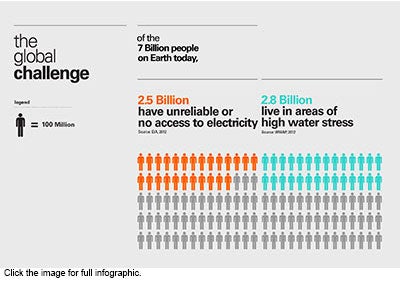
In the past five years, more than 50% of the world’s power utility and energy companies have experienced water-related business impacts. At least two-thirds indicate that water is a substantive risk to business operations. As the world’s population reaches 9 billion, competing demand for water from other sectors is expected to grow, potentially exacerbating the issue.
- South Africa: Lack of sufficient water resources in South Africa have forced all new power plants to shift to dry cooling systems, which cost more to build and are less efficient than water-cooled systems.
- North America: In the United States, a number of power plants were forced to shut down or reduce power generation due to low water flows or high water temperatures, resulting in significant financial losses. In 2012, California’s hydroelectric power generation was 38% lower than the prior summer due to reduced snowpack and low precipitation, further emphasizing the need for integrated energy-water planning to identify and reduce risks, maximize benefits and avoid financial losses.
- India: Last year in India a thermal power plant was forced to shut down because of severe water shortages.
- Australia: During one of the worst droughts in 1,000 years, three coal power plants had to reduce electricity production to protect municipal water supplies in 2007.
 Without significant action, these types of problems are only expected to get worse. By 2035, the world’s energy consumption will increase by 35%, which in turn will increase water consumption by 85%, according to the
International Energy Agency. Climate change will further challenge water and energy management by causing more water variability and intensified weather events, such as severe floods and droughts.
Without significant action, these types of problems are only expected to get worse. By 2035, the world’s energy consumption will increase by 35%, which in turn will increase water consumption by 85%, according to the
International Energy Agency. Climate change will further challenge water and energy management by causing more water variability and intensified weather events, such as severe floods and droughts.
The good news is that solutions to the water-energy challenge exist. The World Bank’s new Thirsty Energy initiative is already working to help governments prepare for an uncertain future by breaking disciplinary silos that prevent cross-sectoral planning. But countries must continue to innovate and adapt policies and technology to address the complexity of the landscape.
With the energy sector as an entry point, Thirsty Energy quantifies tradeoffs and identifies synergies between water and energy resource management. The initiative is also working with the public and private sectors on technological development and adoption, improved operations to reduce water use and impacts in water quality, and integrated planning to assess constraints and synergies between the two resources in a range of countries including South Africa, Bangladesh, Morocco, and Brazil.
Energy systems are becoming more and more vulnerable to the impacts of climate change, which adds uncertainty and risk. If these challenges are not immediately addressed, they could compromise development gains achieved so far and push people further into poverty. The time to act is now.



Join the Conversation